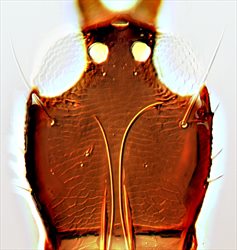
Head of female macroptera
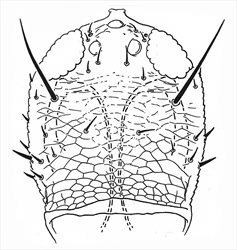
Head of female microptera

Antenna

Antennal segments III-IV
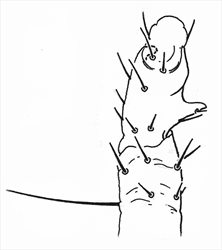
Fore tarsus of small female
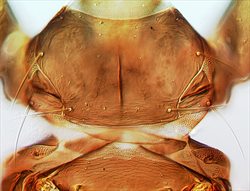
Pronotum
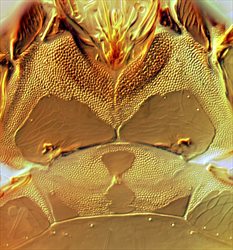
Prosternites
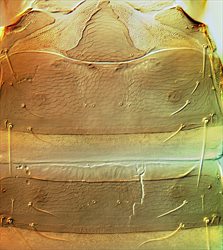
Tergites I-III
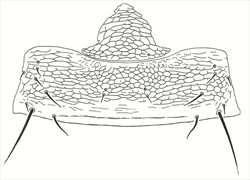
Pelta & tergite II
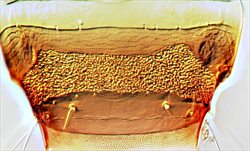
Male sternite VIII
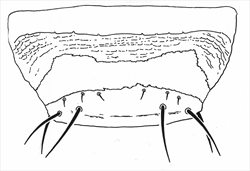
Male sternite VIII
Both sexes either fully winged or with wings shorter than thorax width. Body and legs brown, tarsi and much of fore tibiae yellow, mid and hind tibiae yellow at base; antennal segment III mainly yellow, IV–VI variably yellow at base; fore wings weakly shaded toward apex. Antennae 8-segmented; sense cones longer in winged than wingless individuals, segment III with 3 sense cones of which the inner one is long and curved, IV with 4 sense cones; VIII constricted to base. Head longer than wide, wider across cheeks than across eyes; cheeks convex and constricted to base, without prominent tubercles, but with several small, stout setae; postocular setae long and pointed, wide apart; maxillary stylets retracted to eyes, close together medially. Pronotum without sculpture medially, with stout median apodeme in large males; with 4 pairs of slender pointed major setae, anteromarginals no larger than discal setae; prosternal basantra absent. Fore tarsal tooth small in winged, but large in wingless individuals of both sexes. Metanotum without sculpture medially. Fore wing parallel sided, with about 10 duplicated cilia. Abdominal tergite I, the pelta, with lateral margins curving forward away from tergite II; tergites II–VII with two pairs of sigmoid wing-retaining setae, marginal setae S1 long and pointed; tergite IX setae S1 pointed, less than 0.8 as long as tube.
Males varying in size, large males with fore femora swollen; tergite IX setae S2 short and stout; sternite VIII with transverse pore plate extending full width of sternite posterior to spiracles, median longitudinal length of pore plate 25–40 microns.
The genus Hoplothrips includes about 120 named species, but there are no modern identification keys to any substantial number of species. The most common species are known to exist as both winged and wingless morphs. Moreover, these species exhibit considerable sexual dimorphism, and males of the same species vary in body size, with some structures exhibiting patterns of allometric growth. As a result, species identification is often difficult (Mound & Walker, 1986; Kobro & Rafoss, 2006; Okajima, 2006). Hoplothrips fungi is very similar to, and possibly the same species as H. karnyi from North America, and there are possibly further synonyms in other parts of the world. H. orientalis Ananthakrishnan from India, Australia and New Zealand (Mound & Walker, 1986) is also very similar, but usually has antennal segment IV uniformly brown. In Britain, H. fungi is distinguished from H. corticis and H. ulmi by the long and curved inner sense cone on antennal segment III.
Breeding on the branches and trunks of various dead Angiosperm trees, and presumably feeding on fungal hyphae. The structural polymorphism of this species is presumably associated with the the type of sexual behaviour reported in its North American counterpart, Hoplothrips karnyi (Crespi, 1988).
Widespread and common in England and Scotland, from Kent to northern Scotland (Mound et al., 1976), and found throughout northern Europe, but also recorded from Japan (Okajima, 2006).
PHLAEOTHRIPIDAE - PHLAEOTHRIPINAE
Hoplothrips fungi (Zetterstedt)
Thrips fungi Zetterstedt, 1828: 561
Phloeothrips pini Haliday, 1837: 145
Crespi BJ (1988) Adaptation, compromise and constraint: the development, morphometrics and behavioral basis of a fighter-flier polymorphism in male Hoplothrips karnyi. Behavioral Ecology and Sociobiology 23: 93–104.
Kobro S & Rafoss T (2006) Identification of adult males and females of Hoplothrips species (Thysanoptera: Tubulifera) known from Norway, and some deductions on their life history. Entomologica Fennica 17: 184–192.
Mound LA, Morison GD, Pitkin BR & Palmer JM (1976) Thysanoptera. Handbooks for the Identification of British Insects 1 (11): 1–79.
Mound LA & Walker AK (1986) Tubulifera (Insecta: Thysanoptera). Fauna of New Zealand 10: 1–140.
Okajima S (2006) The Suborder Tubulifera (Thysanoptera). The Insects of Japan 2: 1–720.